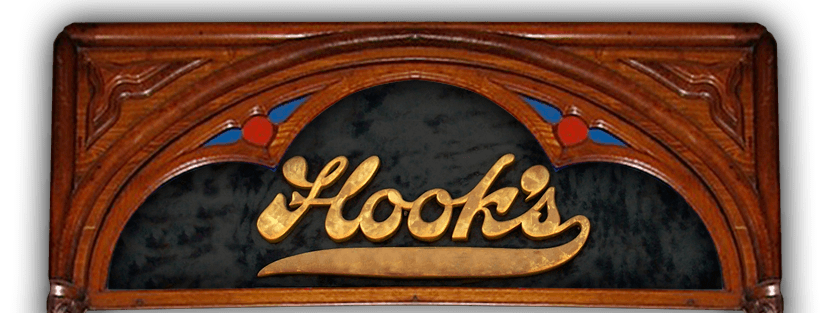 In 1900, John A Hook, the son of German immigrants opened his first “Deutsche Apotheke” (German Apothecary) in a 1,000 square foot building on the near Southeast side of Indianapolis at 1101 S. East St., in the neighborhood of Fountain Square. The original Hook’s store building is no longer standing, but ironically was just a block South of where now the global pharmaceutical company Eli Lilly and Company established their corporate headquarters in the 1880’s and continues to operate today.
In 1900, John A Hook, the son of German immigrants opened his first “Deutsche Apotheke” (German Apothecary) in a 1,000 square foot building on the near Southeast side of Indianapolis at 1101 S. East St., in the neighborhood of Fountain Square. The original Hook’s store building is no longer standing, but ironically was just a block South of where now the global pharmaceutical company Eli Lilly and Company established their corporate headquarters in the 1880’s and continues to operate today.
In 1908 Hook opened a second downtown store at the corner of New Jersey & East Washington Streets in Indianapolis. He also took on a partner — Edward F Roesch.
In 1943, John A. Hook died at age 60 and Ed Roesch became president.
By 1950, Hook’s Drugs, had approximately 50 stores throughout Indiana, and celebrated their Golden Jubilee with the grand opening of a new store at 38th and Meridian Streets.
Edward F Roesch died in August of 1956, allowing F. “Bud” Hook, John’s son, who had been active in the business since he was a teen, to take over as president. The former Purdue University athlete and pharmacy grad helped guide Hook’s Drugs through the postwar era and onto tremendous expansion as one of the largest regional drugstore chains in the US.
In 1966, The Company opened the Hook’s Historical Drug Store and Pharmacy Museum at the Indiana State Fairgrounds as their corporate contribution to the Governor’s request for Indiana based companies to fund special initiatives celebrating Hoosier history and commemorating the state’s sesquicentennial. Hook’s efforts to create the Drugstore Museum and the enthusiastic public response to its opening during the 1966 State Fair led Governor Edgar Whitcomb to recognize the Museum as the most significant corporate contribution to our sesquicentennial celebration.
 Remarkably, the Museum was planned as a “temporary” 3 month exhibit by both Hook’s and the Indiana State Fair when it opened in 1966. As a result of huge attendance and interest after it opened however, Hook’s and the Fair re-considered the future of the exhibit and agreed to keep it open. 2013 will mark the 47th year since our original opening in 1966, as we now plan to celebrate the bicentennial of Indiana Statehood in 2016.
Remarkably, the Museum was planned as a “temporary” 3 month exhibit by both Hook’s and the Indiana State Fair when it opened in 1966. As a result of huge attendance and interest after it opened however, Hook’s and the Fair re-considered the future of the exhibit and agreed to keep it open. 2013 will mark the 47th year since our original opening in 1966, as we now plan to celebrate the bicentennial of Indiana Statehood in 2016.
In order to create the exhibit in a physical structure that achieved the look and feel of an actual historic drugstore, the State Fair agreed to loan the use of a small building originally constructed in the 1920’s for the Public Health Dept. of Indiana to educate new Mother’s on the proper care of their children (The Better Babies Building). Located just inside the main 38th St. gate at the Indiana State Fairgrounds, the building was approximately the correct size for a free-standing old drugstore and well located on a main drive within the fairgrounds, easily accessible to visitors.
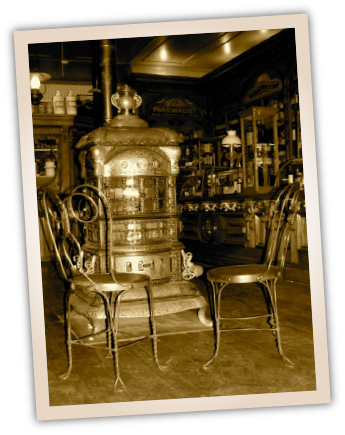 For their part, Hook’s was keen to not simply display an assembly of various drugstore artifacts from the past locked away in sterile glass cases, but rather re-create the complete authentic look and feel of an operating 19th century Indiana drugstore, complete with fixtures, products, and advertising you would have found in such an establishment. Additionally, Hook’s also sought to make the museum more “real” for visitors, by offering many examples of old-style candies, toys, gifts or other similar that were familiar to previous eras and still being produced, so that visitors could in many cases also purchase a bit of the past and take it with them when they left the store. They even offered a limited selection of modern drugstore necessities for first aid, cough and colds, headaches, upset stomachs etc. This combination of offering products for sale, including common over the counter medications in addition to historic exhibits, meant that it wasn’t simply a museum, but to some small degree a functioning drugstore. Offering both nostalgic treats and real drugstore products alongside the historic exhibits made the Hook’s Drugstore Museum very different from every other drugstore museum in the world, and has been an important factor in our longevity and success of nearly fifty years. To the present day, visitors who come into the museum to see historic exhibits can also enjoy great ice cream sodas, buy old-style candies and gifts, and even pick up something to treat their headache, prevent sunburn, replace batteries in their cameras, and much more!
For their part, Hook’s was keen to not simply display an assembly of various drugstore artifacts from the past locked away in sterile glass cases, but rather re-create the complete authentic look and feel of an operating 19th century Indiana drugstore, complete with fixtures, products, and advertising you would have found in such an establishment. Additionally, Hook’s also sought to make the museum more “real” for visitors, by offering many examples of old-style candies, toys, gifts or other similar that were familiar to previous eras and still being produced, so that visitors could in many cases also purchase a bit of the past and take it with them when they left the store. They even offered a limited selection of modern drugstore necessities for first aid, cough and colds, headaches, upset stomachs etc. This combination of offering products for sale, including common over the counter medications in addition to historic exhibits, meant that it wasn’t simply a museum, but to some small degree a functioning drugstore. Offering both nostalgic treats and real drugstore products alongside the historic exhibits made the Hook’s Drugstore Museum very different from every other drugstore museum in the world, and has been an important factor in our longevity and success of nearly fifty years. To the present day, visitors who come into the museum to see historic exhibits can also enjoy great ice cream sodas, buy old-style candies and gifts, and even pick up something to treat their headache, prevent sunburn, replace batteries in their cameras, and much more!
In order to create an absolutely authentic feel to the museum, Hook’s gathered actual antique drugstore artifacts from around the Midwest to fill the space. The jewels of the collections are the beautiful 1850’s pharmacy cabinets brought from Cambridge City, Indiana. The cabinets were made in Cincinnati OH, and shipped to Cambridge City circa 1852 by barge on the newly opened canal system that pre-dated train service in the State. Originally installed in Sam Houshour’s Drugstore when it opened on the National Road (US 40) in the downtown, these cabinets remained in Cambridge City until they were purchased from the Grigsby family for the Drugstore Museum. The fine ash and walnut wood cabinets you see today are not recently restored, but rather represent furnishings that have been carefully cared for by generations. Reportedly the last time the cabinets were “refinished” was during the 1940’s, when Walter Grigsby tried to busy himself by applying a fresh coat of varnish during a time he was worried about his son in World War II. Grigsby’s son did return safely, however by the 1960’s the cabinets were getting so outdated they had been moved out of the drugstore to storage so that the drugstore could be modernized. Grigsby maintained the cabinets in storage and resisted offers to sell them until representatives of Hooks shared their plans for preserving the fixtures and installing them in the Drugstore Museum exhibit.
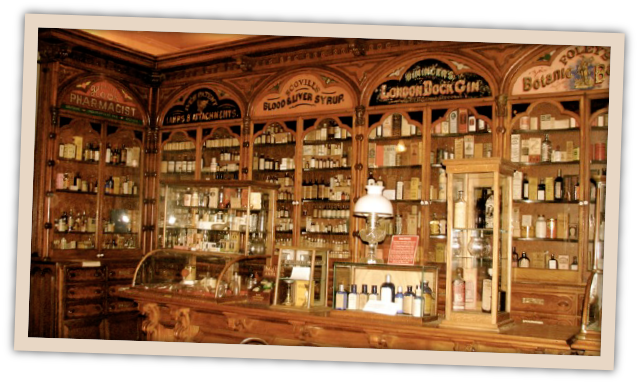
Jim Rogers and Fred Edwards, Hook Drug employees, were originally charged with collecting artifacts to display in the store. Mr. Edwards currently lives in Georgia and has continued working with antiques as a collector, dealer, and appraiser. He keeps in touch with the museum and visits annually. Mr. Rogers is still actively involved in an advisory role in preserving the museum and its collections.
In 1966, during the Indiana State Fair, The (temporary) Hook’s Historical Drugstore and Pharmacy Museum opened to h huge crowds and rave reviews, and even earned special recognition from the Governor. Almost immediately Hook’s knew that the Museum had potential as a permanent fixture and began discussions with the Indiana State Fairgrounds about keeping the Museum open permanently. Except for a period in the late 1970’s when a dispute between the Fairgrounds and Hooks caused the Museum to be closed for about 18 months, the Museum was open daily except major holidays until the year 2000. The Museum was featured regularly in large advertising campaigns by Hook’s until they were bought out by Revco Drug in 1994.
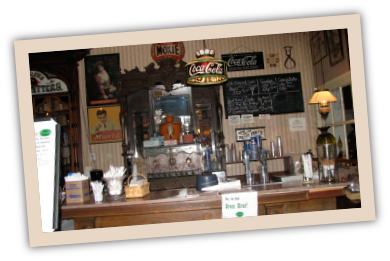 In 1971, The Hook’s Historical Drug Store and Pharmacy Museum added an ice cream soda fountain, a feature that is today still our single most popular attraction. Beginning in the early 1970’s and throughout the time Hook’s maintained ownership of the Museum, large tents would be set-up in front of the Museum during each State Fair to sell the Ice Cream Sodas in special commemorative soda glasses emblazoned with the Hook’s name and logo. These designs and glass styles changed from time to time, and over the years became a sought-after collectible for people who visited the Fair. Today, you can see a selection of these glasses preserved in the collection. In 2012, Autumn Bussen, Hook’s State Fair Manager, revived the tradition of special commemorative soda glasses at the Museum, and you can once again purchase special commemorative soda glasses with the Hook’s logo, as well as a selecton of t-shirts.
In 1971, The Hook’s Historical Drug Store and Pharmacy Museum added an ice cream soda fountain, a feature that is today still our single most popular attraction. Beginning in the early 1970’s and throughout the time Hook’s maintained ownership of the Museum, large tents would be set-up in front of the Museum during each State Fair to sell the Ice Cream Sodas in special commemorative soda glasses emblazoned with the Hook’s name and logo. These designs and glass styles changed from time to time, and over the years became a sought-after collectible for people who visited the Fair. Today, you can see a selection of these glasses preserved in the collection. In 2012, Autumn Bussen, Hook’s State Fair Manager, revived the tradition of special commemorative soda glasses at the Museum, and you can once again purchase special commemorative soda glasses with the Hook’s logo, as well as a selecton of t-shirts.
In 1985, the Kroger Grocery Company acquired Hook’s Drugs to pair with their SuperX Drugstore chain. The buy-out from Kroger was mutually agreed by Hook’s and Kroger as a solution to fend off various hostile take-over bids that were emerging for the Hook’s chain. During the 1980’s and 1990’s several competing drugstore chains larger than Hook’s were all fighting for dominance and hungry for consolidation to outgrow their competition. Excellent logistics, deep market penetration, and dominance of the Midwest region where they operated, as well as excellent management and profitability made Hook’s a prime takeover target. As a condition of the “friendly” buyout with Kroger, most Hook’s stores continued to operate much as before, retaining their name. The Museum continues to operate as before with the new owners sponsorship. In 1994, Kroger finally sold all of their drugstore assets to Revco Drug Company in a new wave of consolidation. With the sale to Revco, the Hook’s name was formally retired and Revco, having no use for a Museum agreed to donate Hook’s Historical Drug Store and Pharmacy Museum to the Hook Drug Foundation, a not-for-profit organization. Ironically, Revco itself did not last long as a separate entity as they were acquired by CVS/pharamcy barely a year after they bought Hook’s. Today, many of the original Hook’s locations still remain operating as CVS/pharmacy. The state of the art logistics and warehousing operations that Hook’s erected on the Northeast side of Indianapolis to serve their chain not only still operates today but has even been significantly expanded by CVS/pharamcy. As recently as 2012, nearly 20 years after the Hook’s buyout, a former Hook’s employee visiting the warehouse facility for a tour was startled to see many of the original totes used in the warehouse to move products back and forth still in use, and still bearing the Hook’s name.
Following the 1994 donation by Revco, Hook Drug Foundation continued operation of the Drugstore Museum staying true to their original primary mission to provide scholarships and grants to promote Pharmacy Education.
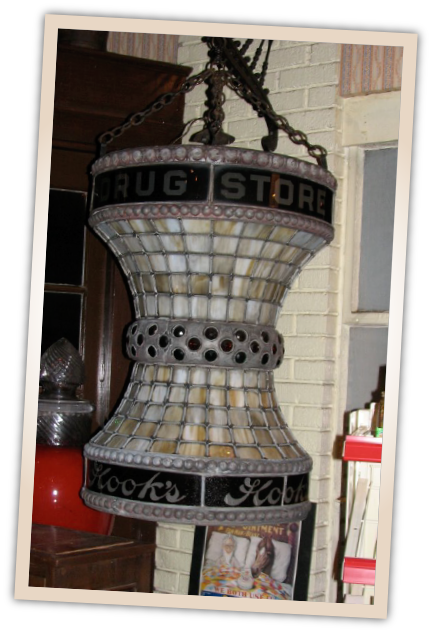 In 1998, the Hook Drug Foundation created a new and separate 501c3 organization to focus entirely on the Drugstore Museum, Hook’s American Drugstore Museum. The new organization planned not just to maintain the current Museum, but hoped to expand it. With the help of a generous seed donation by the Hook family, plans were made to bring a new large national museum to downtown Indianapolis by 2002, dedicated to the history of pharmacy and drugstores. From 1998-2000 a large number of pharmacy artifacts were collected and two prominent downtown buildings were purchased in anticipation of opening the museum. Unfortunately, sufficient funding to complete the vision and open the larger museum in downtown Indianapolis could not be secured, and the downtown buildings were sold. The organization subsequently reformed as the Hook’s Discovery and Learning Center (HDLC) to pursue a new focus on life science and education. Artifacts collected for the pharmacy museum were transferred to a storage facility as the organization followed their new mission in the life sciences education.
In 1998, the Hook Drug Foundation created a new and separate 501c3 organization to focus entirely on the Drugstore Museum, Hook’s American Drugstore Museum. The new organization planned not just to maintain the current Museum, but hoped to expand it. With the help of a generous seed donation by the Hook family, plans were made to bring a new large national museum to downtown Indianapolis by 2002, dedicated to the history of pharmacy and drugstores. From 1998-2000 a large number of pharmacy artifacts were collected and two prominent downtown buildings were purchased in anticipation of opening the museum. Unfortunately, sufficient funding to complete the vision and open the larger museum in downtown Indianapolis could not be secured, and the downtown buildings were sold. The organization subsequently reformed as the Hook’s Discovery and Learning Center (HDLC) to pursue a new focus on life science and education. Artifacts collected for the pharmacy museum were transferred to a storage facility as the organization followed their new mission in the life sciences education.
In 2000, with the new focus of the organization now on life sciences and education instead of history, the Drugstore Museum no longer kept daily hours, and opened only for the annual Indiana State Fair and various private events.
In 2004, Robert Hunt, a resident of Greenfield, IN and an employee of Eli Lilly and Company with an interest in historic pharmacy, approached Hook’s Discovery and Learning Center with the proposal of potentially establishing a drugstore museum in Greenfield. Hunt along with a group of dedicated individuals, incorporated and began preparations for establishing the Greenfield Museum Initiative (GMI).
In February of 2005 The Hook’s Discovery & Learning Center’s board officially offered GMI the opportunity to take over operation of the Hook’s Historical Drug Store and Pharmacy Museum. GMI received 501c3 status from the IRS in March of 2005 and formally became the new “owners” of the Drugstore Museum. GMI worked for 3 years following the transfer of ownership to explore the potential of establishing a drugstore museum in Greenfield IN. By 2008, GMI concluded that there was insufficient financial resources and support to continued planning for a museum in Greenfield. During this same time, the Museum at the Fairgrounds was experiencing excellent growth and success. Renewed interest and success of the State Fair Drugstore Museum prompted GMI to re-focus on Hook’s original mission from 1966. Today we are dedicated to maintaining, promoting, and preserving a world-class museum of pharmacy and drugstore history alongside modern nostalgic products and functioning ice cream soda fountain. This simple but effective formula has carried the Museum forward and sustained it for nearly 50 years.
Despite being one of the oldest attractions at the Indiana State Fair, and originally intended as a 3 month exhibit in 1966, the Hook’s Drugstore Museum not only endures and survives, but thrives. Annual attendance during each Indiana State Fair exceeds 50,000 visitors, and since 2005, the Museum has opened more frequently during other times of the year for weekends and special events to satisfy those longing for a glimpse of drugstore life from a simpler time.
Since opening in 1966, it is estimated that 3 million visitors have crossed our humble threshold into the past. This easily makes Hook’s Drugstore Museum the most well attended exhibit of its kind anywhere in the world today. During 2013, it is estimated the Museum will be open approximately 15-20 weekends in addition to the State Fair. Sales of gifts and ice cream during the Fair has nearly doubled since 2005, as visitors have responded warmly to continuous changes and updates in both the museum displays and gifts / souvenirs. Thanks to the hard work of Greenfield Museum Initiative volunteers and Board Members, our outstanding operations staff, as well as donations from Hook’s Drug Foundation and others, the Museum has achieved a self-sustaining financial stability, assuring the long-term continuation of this Indiana icon. We look forward to a bright future with plans to enhance educational offerings and continued improvements of our displays and exhibits.
